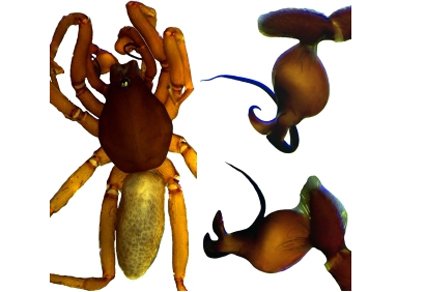Abstract
Eight new harpacteine species, Dasumia antalyaensis sp. nov. (♀), D. capacii sp. nov. (♂♀), D. yagmuri sp. nov. (♂♀), Harpactea bilecenoglui sp. nov. (♂♀), H. elvericii sp. nov. (♂♀), H. bilgenur sp. nov. (♂♀), H. kankilicorum sp. nov. (♂♀) and H. yanardagi sp. nov. (♂) are described from the eastern Mediterranean region of Turkey. Among three new species of Dasumia, D. antalyaensis sp. nov. and D. capacii sp. nov. are related to other congeners known from Turkey, while D. yagmuri sp. nov. is quite different from other known Dasumia species.
Among five new species of Harpactea, three species; H. bilecenoglui sp. nov., H. elvericii sp. nov. and H. yanardagi sp. nov., due to their spiniform emboli, are close to H. sanctaeinsulae and H. isaurica, previously described from Turkey. Two other new speciess, H. bilgenur sp. nov. and H. kankilicorum sp. nov., exhibit the characteristics of the rubicunda species group like almost all of the Turkish Harpactea. However, these two new species have a more complex palp structure.
References
- Alicata, P. (1974) Nuova collocazione sistematica di Harpactea crassipalpis Simon 1882 (Araneae, Dysderidae). Animalia, 1, 39–42.
- Álvarez-Padilla, F. & Hormiga, G. (2007) A Protocol For Digesting Internal Soft Tissues And Mounting Spiders For Scanning Electron Microscopy. Journal of Arachnology, 35 (3), 538–542. https://doi.org/10.1636/Sh06-55.1
- Brignoli, P.M. (1978) Ragni di Turchia V. Specie nuove o interessanti, cavernicole ed epigee, di varie famiglie (Araneae). Revue Suisse de Zoologie, 85, 461–541. https://doi.org/10.5962/bhl.part.82243
- Bristowe, W.S. (1939) The comity of spiders. Ray Society, London vol. 1, 1–228.
- Chatzaki, M. & Arnedo, M.A. (2006) Taxonomic revision of the epigean representatives of the spider subfamily Harpacteinae (Araneae: Dysderidae) on the island of Crete. Zootaxa, 1169, 1–32. https://doi.org/10.11646/zootaxa.1169.1.1
- Danışman, T., Kunt, K.B., Özkütük, R.S. & Coşar, İ. (2023) The Checklist of the Spiders of Turkey. Version 2023. Available from: http://www.spidersofturkey.info (accessed 1 May 2023)
- Deeleman-Reinhold, C.L. (1993) The genus Rhode and the harpacteine genera Stalagtia, Folkia, Minotauria, and Kaemis (Araneae, Dysderidae) of Yugoslavia and Crete, with remarks on the genus Harpactea. Revue Arachnologique, 10 (6), 105–135.
- Dimitrov, D. (2018) A contribution to the study of Turkish Dysderidae with description of a new Dysdera (Araneae, Dysderidae). Arachnology, 17(9), 457–462. https://doi.org/10.13156/arac.2018.17.9.457
- Kunt, K.B., Özkütük, R.S. & Elverici, M. (2011) A survey of east Mediterranean Dasumia (Araneae, Dysderidae) with description of new species. ZooKeys, 137, 89–101. https://doi.org/10.3897/zookeys.137.1783
- Řezáč, M. (2008) Description of Harpactea sadistica n. sp. (Araneae: Dysderidae) – a haplogyne spider with reduced female genitalia. Zootaxa, 1698, 65–68. https://doi.org/10.11646/zootaxa.1698.1.5
- Thorell, T. (1875) Diagnoses Aranearum Europaearum aliquot novarum. Tijdschrift voor Entomologie, 18, 81–108.
- WSC (2023) World Spider Catalog. Version 24.0. Natural History Museum Bern. Available from: http://wsc.nmbe.ch (accessed 01 May 2023)


